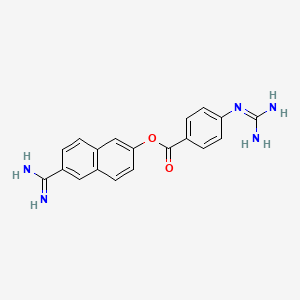



1. 6'-amidino-2-naphthyl 4-guanidinobenzoate
2. 6'-amidino-2-naphthyl 4-guanidinobenzoate, Dimethanesulfonate
3. Benzoic Acid, 4-((aminoiminomethyl)amino)-, 6-(aminoiminomethyl)-2-naphthalenyl Ester
4. Benzoic Acid, 4-((aminoiminomethyl)amino)-, 6-(aminoiminomethyl)-2-naphthalenyl Ester, Dihydrochloride
5. Benzoic Acid, 4-((aminoiminomethyl)amino)-, 6-(aminoiminomethyl)-2-naphthalenyl Ester, Dimethanesulfonate
6. Ckd-314
7. Ckd314
8. Fut 175
9. Fut-175
10. Nafamostat Dihydrochloride
11. Nafamostat Mesilate
12. Nafamostat Mesylate
13. Nafamstat Mesilate
14. Ronastat
1. 81525-10-2
2. Nafamostat [inn]
3. Nafamstat
4. (6-carbamimidoylnaphthalen-2-yl) 4-(diaminomethylideneamino)benzoate
5. Chembl273264
6. Y25lq0h97d
7. P-guanidinobenzoic Acid Ester With 6-hydroxy-2-naphthamidine
8. Nafamostat (inn)
9. Benzoic Acid, 4-((aminoiminomethyl)amino)-, 6-(aminoiminomethyl)-2-naphthalenyl Ester
10. 6-carbamimidoylnaphthalen-2-yl 4-guanidinobenzoate
11. Nafamostatum [latin]
12. Nafamostatum
13. Nafamostat Mesylate(fut-175)
14. 6-[amino(imino)methyl]-2-naphthyl 4-{[amino(imino)methyl]amino}benzoate Dimethanesulfonate
15. Ncgc00160398-01
16. 6-amidino2-naphthyl 4-guanidinobenzoate
17. Unii-y25lq0h97d
18. Nafabelltan
19. Ckd314
20. Ckd-314
21. Nafamostat [mi]
22. 6-(aminoiminomethyl)-2-naphthalenyl 4-((aminoiminomethyl)amino)benzoate
23. Nafamostat [who-dd]
24. Bspbio_001194
25. Schembl135503
26. Gtpl4262
27. Dtxsid0048420
28. Amy8858
29. Chebi:135466
30. Hms3742k19
31. Albb-027243
32. Bcp13085
33. Hy-b0190
34. Zinc3874467
35. Bdbm50063698
36. Akos017259237
37. Db12598
38. 6-amidino-2-naphthyl P-guanidinobenzoate
39. Ncgc00160398-02
40. Ncgc00160398-03
41. Ncgc00160398-04
42. Ncgc00160398-13
43. Bs-17665
44. B1177
45. Ft-0629861
46. Fut-175; Fut 175; Fut175
47. D08240
48. Mls-0435512.0001
49. Ab01566816_01
50. 525n102
51. A840154
52. Q15409374
53. (6-carbamimidoyl-2-naphthyl) 4-guanidinobenzoate;nafamostat
54. (6-carbamimidoylnaphthalen-2-yl) 4-carbamimidamidobenzoate
55. 4-guanidino-benzoic Acid 6-carbamimidoyl-naphthalen-2-yl Ester
56. 6-carbamimidoylnaphthalen-2-yl 4-[(diaminomethylidene)amino]benzoate
57. 4-guanidino-benzoic Acid 6-carbamimidoyl-naphthalen-2-yl Ester(fut-175)
58. Benzoic Acid, 4-[(aminoiminomethyl)amino]-,6-(aminoiminomethyl)-2-naphthalenyl Ester
59. Benzoic Acid, 4-[(aminoiminomethyl)amino]-, 6-(aminoiminomethyl)-2-naphthalenyl Ester, Methanesulfonate (1:2)
| Molecular Weight | 347.4 g/mol |
|---|---|
| Molecular Formula | C19H17N5O2 |
| XLogP3 | 2 |
| Hydrogen Bond Donor Count | 4 |
| Hydrogen Bond Acceptor Count | 4 |
| Rotatable Bond Count | 5 |
| Exact Mass | 347.13822480 g/mol |
| Monoisotopic Mass | 347.13822480 g/mol |
| Topological Polar Surface Area | 141 Ų |
| Heavy Atom Count | 26 |
| Formal Charge | 0 |
| Complexity | 552 |
| Isotope Atom Count | 0 |
| Defined Atom Stereocenter Count | 0 |
| Undefined Atom Stereocenter Count | 0 |
| Defined Bond Stereocenter Count | 0 |
| Undefined Bond Stereocenter Count | 0 |
| Covalently Bonded Unit Count | 1 |
Used as an anticoagulant in patients with disseminative blood vessel coagulation, hemorrhagic lesions, and hemorrhagic tendencies. It prevents blood clot formation during extracorporeal circulation in patients undergoing continuous renal replacement therapy and extra corporeal membrane oxygenation.
Nafamostat is a fast-acting proteolytic inhibitor used during hemodialysis to prevent the proteolysis of fibrinogen into fibrin by competitively inhibiting several serine proteases including thrombin. It improves acute pancreatitis and prevents blood clot formation during extracorporeal circulation and has an anti-inflammatory effect in vitro. A study suggets that nafamostat has a neuroprotective role during ischemia-induced brain injury from antithrombin activity.
Complement Inactivating Agents
Compounds that negatively regulate the cascade process of COMPLEMENT ACTIVATION. Uncontrolled complement activation and resulting cell lysis is potentially dangerous for the host. (See all compounds classified as Complement Inactivating Agents.)
Anticoagulants
Agents that prevent BLOOD CLOTTING. (See all compounds classified as Anticoagulants.)
Serine Proteinase Inhibitors
Exogenous or endogenous compounds which inhibit SERINE ENDOPEPTIDASES. (See all compounds classified as Serine Proteinase Inhibitors.)
Trypsin Inhibitors
Serine proteinase inhibitors which inhibit trypsin. They may be endogenous or exogenous compounds. (See all compounds classified as Trypsin Inhibitors.)
Anti-Inflammatory Agents, Non-Steroidal
Anti-inflammatory agents that are non-steroidal in nature. In addition to anti-inflammatory actions, they have analgesic, antipyretic, and platelet-inhibitory actions. They act by blocking the synthesis of prostaglandins by inhibiting cyclooxygenase, which converts arachidonic acid to cyclic endoperoxides, precursors of prostaglandins. Inhibition of prostaglandin synthesis accounts for their analgesic, antipyretic, and platelet-inhibitory actions; other mechanisms may contribute to their anti-inflammatory effects. (See all compounds classified as Anti-Inflammatory Agents, Non-Steroidal.)
Protease Inhibitors
Compounds which inhibit or antagonize biosynthesis or actions of proteases (ENDOPEPTIDASES). (See all compounds classified as Protease Inhibitors.)
Route of Elimination
Two metabolites of NM, p-guanidinobenzoic acid (PGBA) and 6-amidino-2-naphthol (AN), are renally excreted. Nafamostat accumulates in the kidneys.
Nafamostat is mainly hydrolyzed by hepatic carboxyesterase and long-chain acyl-CoA hydrolase in human liver cytosol. Main metabolites are p-guanidinobenzoic acid (PGBA) and 6-amidino-2-naphthol (AN) as inactive protease inhibitors.
Approximately 8 minutes
Nafamostat mesilate inhibits various enzyme systems, such as coagulation and fibrinolytic systems (thrombin, Xa, and XIIa), the kallikreinkinin system, the complement system, pancreatic proteases and activation of protease-activated receptors (PARs). Nafamostat inhibits lipopolysaccharide-induced nitric oxide production, apoptosis, and interleukin (IL)-6 and IL-8 levels in cultured human trophoblasts. It is shown to act as an antioxidant in TNF--induced ROS production.